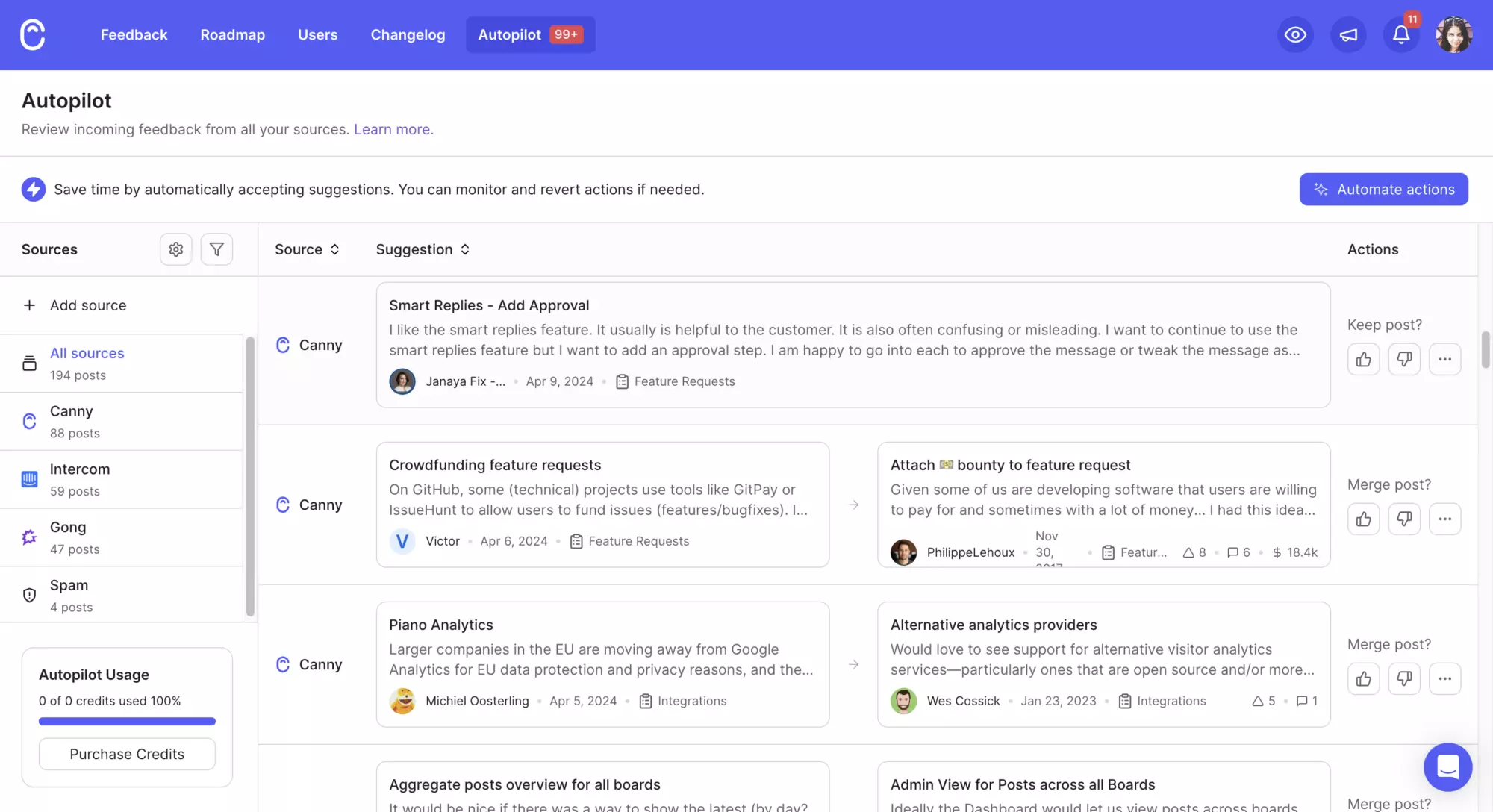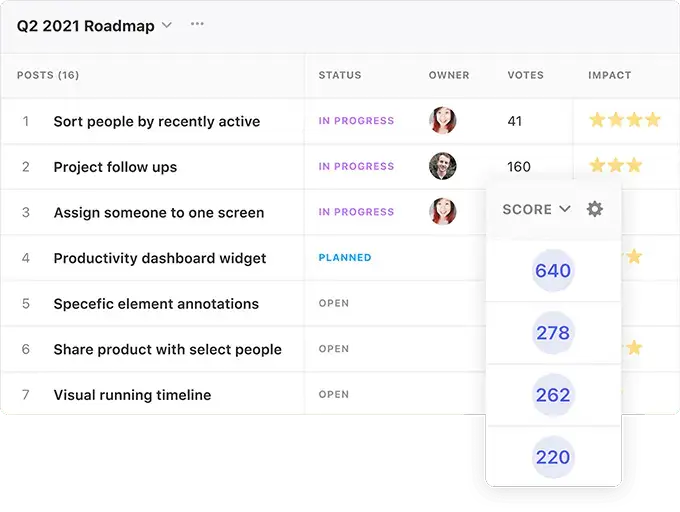When you’re coming up with B2B SaaS product ideas, you need to focus on your target customer.
What are they struggling with? What have they asked you for? How can you help them improve their business?
Let’s take a closer look at some ways you can generate product ideas that align with user needs👇
1. Gather customer feedback
Collect feedback and ideas from the people that matter most…your target audience.
Here’s how to gather user feedback during the product ideation process.
Use a customer feedback platform
Give your customers a place to leave feedback for you. Canny’s feedback boards are a great option. You can direct your users to them to leave feedback at any time.

Your team can also add feedback on behalf of your customers. Integrations with support tools like Intercom, Zendesk, and Help Scout let your team capture feedback while chatting with customers.
You can go a step further, and use Canny Autopilot to capture feedback from conversations automatically. Its AI finds feedback with a high-degree of accuracy and adds it to Canny for you.
Canny also handles deduplication, so you can keep everything organized and see how many people are interested in ideas.
Poll and survey loyal customers
Send polls and surveys to your long-term customers via email.
Categorize the feedback you receive from each customer user group. For instance, your project management users may ask for client portals. And your HR management users may suggest specific integration options.
Review ratings, reviews, and feedback comments
Look through past and recent customer feedback. Use a social listening tool to find comments, ratings, and reviews. You can also check review sites like G2 and Capterra for more user experience feedback.
To automate the process and check multiple sources at once, try Canny Autopilot. Autopilot captures feedback from ten review sources. This includes G2, Capterra, App Store, Google Play, Trustpilot, and more.
Learn how Canny Autopilot can capture all product feature requests effortlessly!

Engage with your community
Use community engagement channels to your advantage. Try LinkedIn, your email list, and relevant Facebook groups. You can also ask users on X and in your own community space if you have one.
Use these channels to gather feedback, fresh ideas, and customer experience insights.
Be specific when asking for comments. You can also include polls to make your posts more actionable.
For example, if you’re looking to create a new grammar checker, you might ask…
What do you look for in an online proofreading tool? Which proofreader are you currently using, and which features do you love/hate? Which features would you like to improve? What new features should we add?
Include some multiple-choice answers – but also leave an option for open feedback. Segment your poll results by user group.
2. Conduct user interviews
Engage directly with customers through interviews. Schedule customer interviews with different user groups. Make sure to gather insights about each segment’s needs and experiences.
During interviews, ask about their:
- Goals
- Friction areas
- Expectations
- Roadblocks
- Pain points
- Concerns
Be sure to also ask them what they love about your current products and what they’d like you to create next.
3. Conduct market research and consider user pain points
Look through market insights to uncover trends, competitor activity, and innovation opportunities.
Consider your unique business model and business objectives when researching different ideas.
For example, if you want to help businesses create timelines with AI, research both subjects. Learn what your target market struggles with when creating project timelines. Also learn what AI tools are currently on the market for project managers.
What gaps can you spot? Is there an existing product that’s similar to your new product idea? Where can your company swoop in and grab a slice of the market share?
Marty Cagan, a renowned product leader, emphasizes solving user problems over merely building features when creating a product strategy. Marty advocates for continuous customer feedback loops through interviews, surveys, and empathy mapping.
During your research and problem-solving ideation session, note and organize what you learn. See if you can uncover user pain points and solve them.
For example, you may discover:
- Project managers struggle to estimate project turnaround times
- AI tools can automate timelines – but need manual input for turnaround time estimates
With that, you could come up with an idea that helps project managers automate timelines. Your tool could estimate turnaround times depending on each project they manage.
4. Assemble a dynamic team
To innovate, you need creative thinking on your product team. But how do you attract that kind of talent?
That’s where your recruitment and/or HR team comes in. Make sure they understand how important ideation is for your business. Tell them to find you candidates who demonstrate a proven track record to come up with impactful product ideas. Look for people who prioritize customer centricity.
Believe it or not, the HR tool your team uses plays a big impact. Finding the best HR software for your team is key
With good HR software solutions, you can streamline your recruitment processes and attract the best and brightest minds in your industry. These tools offer advanced features for talent acquisition, so you can identify and engage with top candidates efficiently.

From automated resume screening to AI-driven candidate matching algorithms, HR software can help you find people with diverse skill sets that support successful product innovation.
5. Manage idea collection
Use the following idea generation and management techniques to gather new ideas and stay organized.
Use an idea management system
Choose an idea management hub or home base to organize your digital product ideas.
One easy way to do this is to create a Canny board for your product ideas. This keeps all your ideas organized in one place. It also combines similar ideas and lets your team and users discuss ideas.
Capture customer and employee ideas
Set up systems that gather and sort out thoughts from both customers and people on your product design team.
Once you have your idea board, focus on collecting new ideas. Consider these tactics:
- Let users share new ideas on your board
- Automate customer experience surveys to capture ideas
- Ask your internal team for innovative ideas.
- Schedule a routine brainstorming session or ideation workshop. (Maybe monthly or quarterly, depending on your innovation goals.)
- Monitor your competition and take note of new ideas they ship
Encourage your team to work together to come up with fresh ideas and innovative solutions during these dedicated windows.
When your team has a new idea that sounds promising, create a demo video to help everyone envision the product management process from idea to done. Use a text-to-speech tool to create lifelike voice-overs for your videos. This makes it easier to explain and showcase creative ideas in an engaging way.
Rank and focus on ideas without bias
Create an idea ranking system so you can focus on the best options.
In Canny, you can create a prioritization roadmap with your own custom prioritization formula. It automatically scores any ideas you add, giving you an objective ranking of your ideas.

Set rules and steps to decide which ideas are most important. Then, choose the ones that align best with your strategic objectives.
Assign ideas
Divvy out ideas to the right product teams. Make sure someone owns each idea.
Clearly communicate which new products, features, or enhancements they need to focus on. Share the demo videos you created and the product feedback you organized, too.
Why?
Managing expectations is so important. When you assign ideas to relevant teams, share why they made the cut to help get everyone on the same page. Your stakeholders, including your customers, will appreciate it.
6. Perform usability tests
Make sure your SaaS product ideas can pass usability checkpoints.
When performing these, check if each product is easy and helpful to use. They should never be confusing or frustrating for your target customer.
Ask user segments to try out your new features or products and tell you what they think. If they have trouble with something, jot it down so you can fix it later.

During these tests, watch closely to see if anyone gets stuck or confused while using a product. Ask them questions to understand why they did something a certain way. This helps you figure out where you can make things better and what you can enhance. Those ideas are invaluable because they solve observed customer pain points.
Your goal is to make the product the best it can be for everyone who uses it.
Use these tests to polish your products until they shine.
7. Play innovation games
Innovation games are a fun way to brainstorm ideas and uncover what customers want.
These games help teams get creative and collaborate. They make it easier to surface hidden needs and pain points.
While they’re often played with customers, you can also run them with your team. Sure, the results might differ since your teammates know the product better—but you’ll still gain valuable insights. Later, test these games with actual users and compare the findings.
Each game needs a facilitator—ideally a product manager or owner.
Here are a few games you can try:
- Buy a Feature – help teams prioritize features
- Me and My Shadow – highlights user behavior and hidden usability issues
- Speed Boat – identifies what’s slowing down the product
- Product Box – teams create a mock product box to see what stands out most
To get started, set clear goals. Choose games that fit your time and align with team objectives. Rotate through different ones to keep the ideas fresh. Gather feedback after each session to improve and keep the ideation process effective.
It’s time to align your product development process with user needs
When you focus on what your ideal customer wants and needs, everything falls into place.
You build apps businesses love using. You add features your clients can’t live without. And you scale ideas without worrying if they’ll fail.
Simplify the product development process with Canny today.
Here’s to your success!







